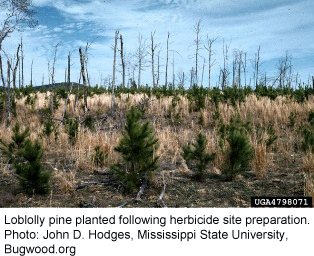Herbicides
Preparing for Planting (Site Preparation)

__________________________________________________
Adequate site preparation and a good planting job are the keys to successful plantation establishment. The most important objectives of site preparation are to control vegetation and improve soil conditions. The combined use of herbicides to control brush and herbaceous weeds and site preparation burning to reduce logging debris generally provides the most cost effective approach to prepare upland sites. However, on poorly drained soils of the Coastal Plain, machinery is often used to improve soil drainage (bedding). Some common herbicide treatments for site preparation on upland or poorly drained sites in the southeastern Coastal Plain include:
Upland sites characterized by sandy soils and predominant woody vegetation including various oaks, sweetgum, cherry, persimmon, hickory, red maple, and others:
Apply the combination of 40 oz Chopper® Gen 2 (imazapyr) plus 2.5 qts Accord® XRT (glyphosate) per acre as a broadcast foliar spray by ground equipment or helicopter between June and September. Following a harvest, allow brush to grow about waist high to ensure adequate herbicide uptake through foliage. A broadcast burn may be done to improve planting access, but do not burn for six weeks after treatment to ensure adequate time for herbicides to translocate to hardwood root systems.
Upland sites similar to above, but where waxy-leafed vegetation is abundant, such as yaupon, waxmyrtle, magnolia or bay species:
Follow the general recommendations for upland sites above, but apply the combination of 40 oz Chopper® Gen 2 (imazapyr) plus 1.5 qts Garlon® 4 Ultra (triclopyr) per acre as a broadcast foliar spray by ground equipment or helicopter between June and October.

Herbicide site preparation research at the University of Florida for bedded, poorly drained Coastal Plain sites. Photo: Patrick Minogue, University of Florida
Poorly drained sites should be bedded using heavy equipment to improve drainage. About six weeks after forming beds in late summer, a combination of 32 oz Chopper® Gen 2 plus 3 oz Oust® XP (sulfometuron methyl) per acre may be applied to a six to eight foot wide band on the top of the bed. Where blackberry is abundant, add 1.5 qts Accord® XRT II per acre to this combination. Where shrub vegetation such as gallberry, palmetto or fetterbush have developed on beds use a combination of 32 oz Chopper® Gen 2 plus 1.5 qts Garlon® 4 Ultra per acre as a banded treatment on bed centers prior to planting pines.
Other options: The common herbicide site preparation treatments described above work across a wide range of site conditions, but many other site preparation options may be tailored to particular sites. For example, Velpar® is very effective on sandy soils where oaks are the predominate species. Another herbicide, Escort® (metsulfuron methyl) is added to herbicide combinations to control blackberry, but Garlon® is also effective for this use. As noted above, developing site-specific treatments is quite complex; many factors must be considered including the costs of both herbicides and application method. The treatments presented here are intended to provide general guidelines, but landowners are encouraged to seek the guidance of experienced commercial forest herbicide applicators and consulting foresters.
Click here for common herbicide products for forest site preparation.